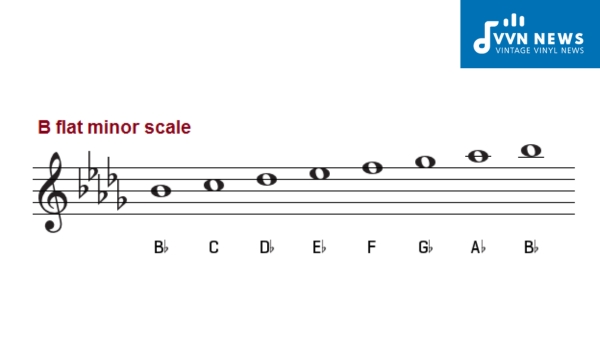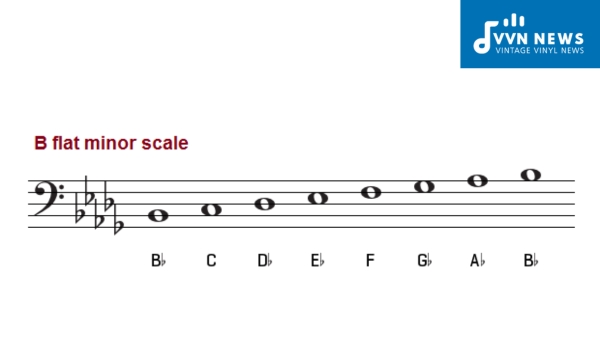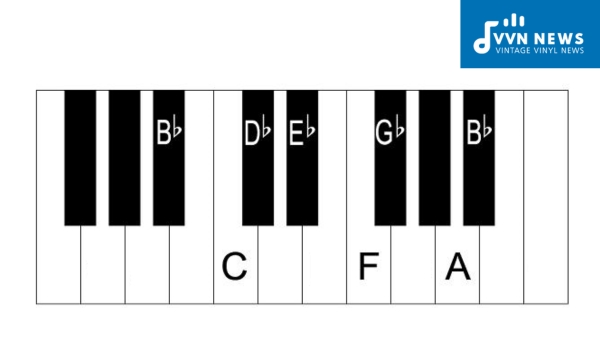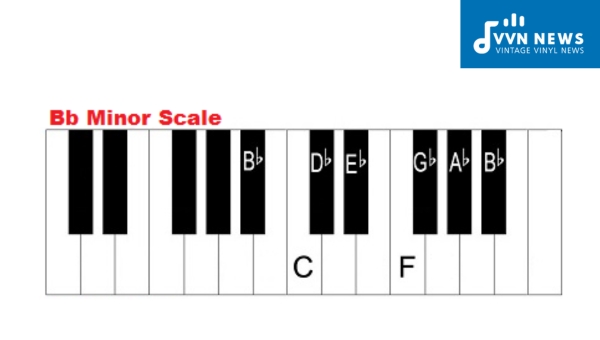Music can be compared to the endless realms of a fascinating galaxy.
Within this galaxy, there resides a constellation known as the B flat minor scale—an intriguing paradox of simplicity and depth that shines brighter as you delve deeper into its origins and applications.
Just as observing the cosmos encourages contemplation, your musical journey demands an investment of time, focus, and passion.
The beauty inherent in the notes of the B flat minor scale invites every music enthusiast to discover its magic.
As one steps into this world, one encounters an array of sounds that summon emotions ranging from somber reflection to uplifting inspiration.
Allowing yourself to engage with this remarkable scale will provide not only a deep appreciation for its structure but also elevate your understanding of music overall.
How to Construct the B Flat Minor Scale?
Creating the B flat minor scale revolves around a fundamental formula that is intricately woven through many scales, regardless of key.
To devise this enigmatic scale, simply follow a pattern of Tone, Semitone, Tone, Tone, Semitone, Tone, and Tone.
This unique sequence paves the way toward mastering the B flat minor scale:
- Start on B flat.
- The following note is a Tone higher: C.
- Next comes a note a Semitone higher: C sharp or D flat.
- Move another Tone up to reach D sharp or E flat.
- Another Tone brings you to F.
- Following this with a Semitone, you get to F sharp or G flat.
- An additional Tone leads to G sharp or A flat.
- The sequence is concluded with another Tone, landing again on B Flat.
While embarking on this intricate journey of creation, it is critical to focus on each changing note’s quality; whether it be an ascent or descent in tone or semitone.
This approach of delving in deep and paying careful attention aids one in achieving an impressive command over the intriguing ‘B Flat Minor Scale’.
What are the Degrees in the B Flat Minor Scale?

When we delve into the degrees of the B flat minor scale, we find its compelling structure.
Essentially, each note within a scale corresponds to a specific degree. The B flat minor scale possesses seven degrees, namely:
- First degree: B flat (root)
- Second degree: C
- Third degree: D flat
- Fourth degree: E flat
- Fifth degree: F
- Sixth degree: G flat
- Seventh Degree: A flat
Each degree holds a crucial role, adding to the depth and richness of melodies and harmonies curated around this scale.
The know-how of these degrees plays an intricate part in musical compositions, from crafting chords to developing melodic lines.
Also Read: What Are The Three Types Of Minor Scale? [Explained]
Playing the B Flat Minor Scale on Piano and Guitar
Navigating the B flat minor scale can be an exciting journey, rich in learning and exemplifying the contours of musical language.
Let’s delve into how you can run your fingers over this remarkable sequence of pitches on both the piano and guitar.
Playing the B Flat Minor Scale on Piano
Playing scales, like the B Flat Minor scale, on a piano infiltrates your musical prowess with a range of benefits.
It equips you with valuable technique, widens your familiarity with various keys, and inherently tunes your ears to perceive different nuances in sound.
Here are the steps to master the art of playing B Flat Minor scale on a piano:
- Position your fingers appropriately: Your thumb (finger 1) should strike note B flat, pointer finger (2) hit C, and middle finger (3) press D flat.
- Transition through fingers: Cross your thumb under your third finger and let it hit E flat. The same sequence continues with the pointer finger on F and the middle finger on G flat.
- Carry out this progression until A flat is hit by thumb; next comes B flat propelled by index finger while middle one lands on C.
- Thumb crosses under again to hit D flat; pointer then progresses towards E flat and hand position resets for finishing remainder of octave.
To return down:
- Reverse this sequence starting by hitting E flat with index (2), transitioning thumb under to touch D flat.
- Involving middle finger for striking C while pointer engages with B flats and thumbs approach A flats diligently.
- Grasping G flat with the middle and crossing over the ring or fourth finger permits the pinky or fifth one to hit F.
- Retreat to the start point via playing remaining notes using similar hand movements outlined for initial ascent.
Playing B Flat Minor Scale on Guitar
Similarly, any guitarist knows minor scales furnish a path towards deeper musical depth, particularly our subject of interest—B Flat minor scale.
Provided below is guidance for approaching this scale on guitar:
- Find where B-flat is located: On a sixth string of a guitar, locate the first fret that represents the note of interest i.e., B-flat.
- Ascend in sequence: Initiate profile by striking this B flat, progressing to C (third fret, fifth string), and then to D flat (sixth fret, fifth string).
- Continue linear progression: Strike E flat (first fret, fourth string), advancing towards F (third fret, fourth string), and subsequently to G flat (fifth fret on the fourth string).
- Completion of sequence notes: Finally, approach A flat (first fret, third string) and end on B flat again.
Retreating down the scale is just as fulfilling. Simply reverse the above process, starting at the highest note attained and descending backward.
Also Read: E Minor Scale Explained [Improve Your Guitar Skills Today]
What does the B Flat Minor Scale look like in various clefs?

The B flat minor scale, like all scales in music, can be notated in different clefs.
Each clef offers a unique representation of the scale, enabling you to visualize and play it on a variety of instruments.
Below, we delve into how this mysterious scale is represented in the treble, alto, bass, and tenor clefs.
Treble Clef
The treble clef falls into the upper range of the musical staff. It’s frequently used for high-pitched instruments, such as the violin, flute, trumpet, or even the right hand on a piano.
When projected on this staff line, the B flat minor scale follows: B♭ – C – D♭ – E♭ – F – G♭ – A♭ – B♭. The first note (B flat) is found directly in the middle of the third line from the bottom.
Alto Clef
Unique and less common is the alto clef, which has its peculiarities despite being less generally applied than its treble and bass counterparts.
Primarily utilized for viola music and sometimes trombone music too, in alto clef formation, your B flat minor scale’s pattern comes out to be: B♭ – C – D♭ – E♭ – F – G♭ – A♭- B ♭.
Although similar sounding to its treble and bass counterparts when played, it is quite distinct in notation.
Bass Clef
Often used by low-brass instruments, cellos, bassoons, and of course, our beloved left hand on a piano is the bass clef.
It lends itself well to revealing lower register notes like those that frequently occur in our discussed subject-scape—the B flat minor scale.
Following this guideline, then B ♭ – C – D ♭ – E ♭ – F – G ♭– A ♭–B ♭ is your guide through which you would see rightly-organized smokiness come from this scale’s depth plunge.
Tenor Clef
The tenor clef mainly finds use with larger orchestral instruments: trombone, bassoon, and cello for higher ranges sometimes.
We’ll find mirrored here again the B flat minor scale’s ever-elusive structure: B ♭ – C – D ♭- E ♭ – F – G ♭ – A ♭ – B ♭.
It certainly will hold intrigue for those exploring this not-as-oft-used clef.
It’s essential to recall that while the presentations and uses of these clefs vastly differ, they all point towards sketching out a similar sound picture—the enchanting narrative of the B flat minor scale.
Also Read: How To Transpose Bass Clef To Treble Clef [A How-To Guide]
B Flat Minor Scale Key Signature
The B flat minor scale, your melodic guide through evocative ballads or energizing rock anthems, treads on the path of five flats.
These flats include – Bb, Eb, Ab, Db, and Gb. The key signature of this scale comprises these same five flats, giving it a distinct identity in the musical spectrum.
Following this unique pattern of flats forms an essential part of navigating through the B flat minor.
A systematic grasp of this characteristic unlocks an influential tool for every music lover in pursuing their creativity.
Respecting this spectacle displays your dedication and contributes to the enhancement of your melodic skills.
Relative Major Key of B Flat Minor Scale

The intricacies of music theory often surprise us with their patterns and relationships.
In this interactive cosmos, every minor scale has a relative major scale. The concept is reciprocal; every major scale also carries a conjoined minor scale.
The relative major key of the B Flat Minor Scale is D Flat Major. This beautiful interconnection arises because they share the same set of notes, just with different starting points.
D Flat Major commences from ‘D flat,’ while B Flat Minor initiates its musical journey from ‘B flat.’
These two scales intertwine, creating harmonious sonic fusion, and showcasing music’s elegant symmetry.
B Flat Minor Scale Chords
In the marvelous realm of the B Flat Minor scale, you’re introduced to a variety of chords, each with its unique sound and mood.
Your musical journey within this key will feature seven primary chords:
- Bb minor (I): Bb – Db – F
- C diminished (ii°): C – Eb – Gb
- Db Major (III): Db – F – Ab
- Eb minor (iv): Eb – Gb – Bb
- F minor (v): F – Ab – C
- Gb Major (VI): Gb – Bb – Db
- Ab Major (VII): Ab – C – Eb
Through mastering these chords, you will masterpieces that stimulate an array of sensory experiences.
Also Read: A Flat Minor Pentatonic Scale [Unleash Subtle Tension In Your Music]
FAQs About The B Flat Minor Scale
Can beginners start learning from the B flat minor scale?
Yes, even if it looks slightly intimidating at first, the B flat minor scale can be an exciting option for beginners to explore, giving them an edge in their musical journey.
How is the emotion of a song affected by the B flat minor scale?
The B flat minor scale often imbues the music with a deeper, somewhat melancholic resonance that can provoke thoughtful emotionality in listeners.
How many sharps or flats are there in the B-flat minor scale?
The key of B-flat minor consists of five flats namely B, E, A, D, and G.
What’s the relation of Chopin with the B flat minor scale?
The celebrated composer Frédéric Chopin notably used the emotive potential of this key in several compositions like his “Piano Sonata No. 2.”
Does playing in different keys affect an instrument’s tone quality?
Yes. Each key forces a different set up of open and closed sounds leading to variation in timbre or what some describe as ‘color’.
Conclusion
Stepping into the universe of the B flat minor scale can be a transformative journey.
This diverse scale acts as a conduit, channeling the power of music into our lives, stirring emotions, fueling creativity, and empowering expression.
Whether you’re unlocking its secrets on the piano or plucking out its notes on a guitar, each encounter is enriching.
It belongs not only to professional musicians but also to everyone who dares to explore.
Grasp its fundamentals, and don’t hesitate to experiment – your musical journey is about discovery and personal growth!








